How to Create Personalized Product Demos? (Steps Inside)
In today’s competitive marketplace, simply having a good product isn’t enough to grow your pipeline. Businesses face the challenge of standing out and building authentic connections with potential customers. Many struggle to make their marketing and product demos resonate in a crowded field, often feeling their efforts are lost in a sea of generic pitches.
For product managers, this can be particularly frustrating. Conventional demos may fail to capture the audience's attention or effectively showcase the product’s value. Personalizing these demos is key to overcoming this challenge, making your product’s benefits clear and compelling to your target audience.
In this blog, we’ll first learn about sales demo personalization and why there's a need to do it. Then, we'll explore the various ways to master personalized product demos. So, let's begin!
What is a Personalized Product Demo?
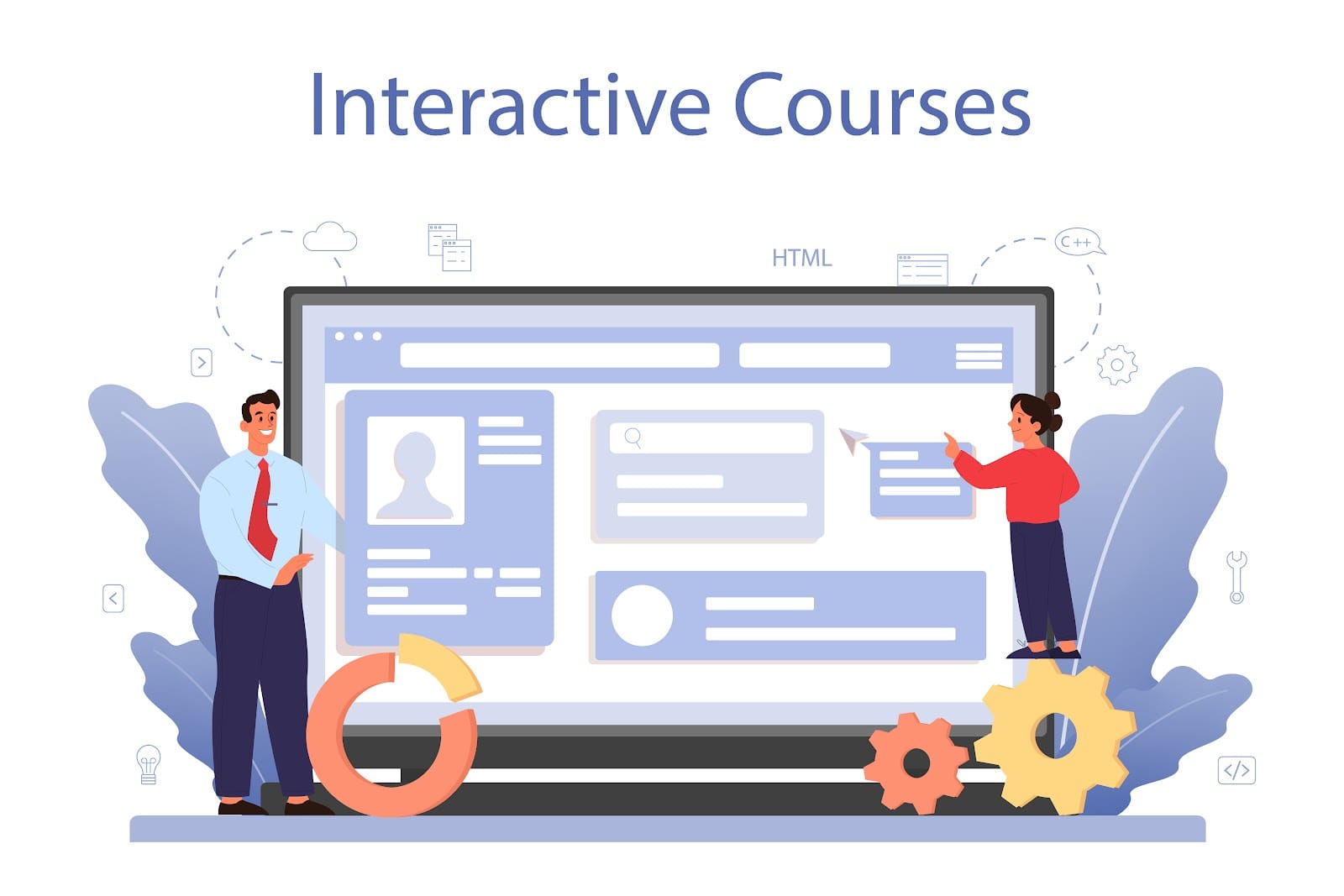
Think of demo personalization as crafting a story where your prospect is the hero, and your product is the ultimate solution to their challenges. It’s about customizing every aspect of the demo to highlight how your product solves their unique pain points, speaks to their goals, and fits their vision.
By making the experience personal and relevant, you turn a generic pitch into a conversation that resonates, inspires confidence, and builds a connection.
Why Does Demo Personalization Matter?
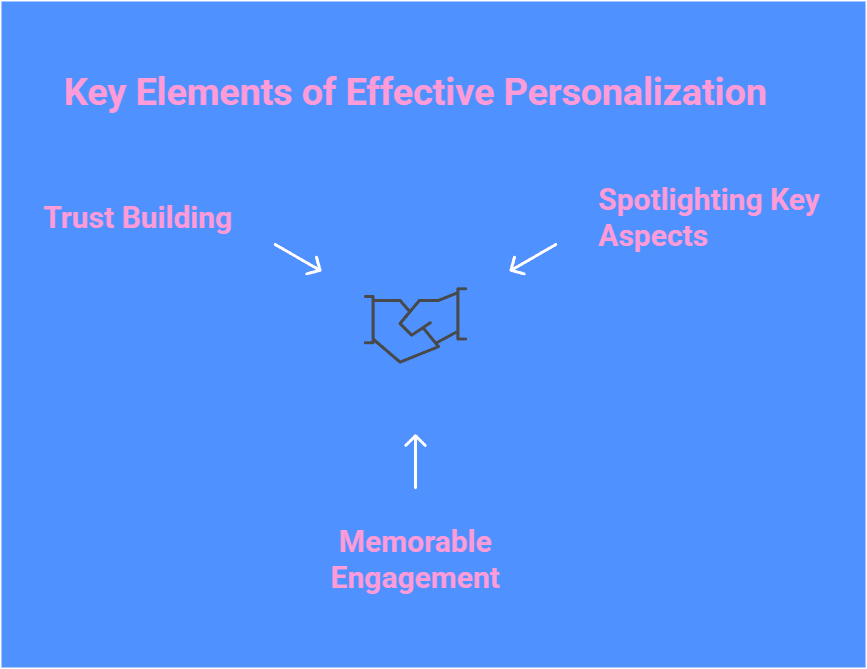
Are you wondering about the reasons behind personalizing product demos? Learn why personalization transforms ordinary demos into deal-closing power plays:
1. Spotlighting What Matters Most
Your prospects don’t want to see every feature—they want solutions to their problems. A personalized demo zeroes in on their specific needs, showcasing how your product addresses their challenges and delivers real value. It’s about showing, not telling, why your solution is the perfect fit.
2. Creating Memorable Engagement
An engaging custom demo isn’t just informative—it’s magnetic. When prospects see their priorities reflected in the demo, they stay engaged and invested. Whether it’s highlighting data management for a tech-savvy buyer or marketing tools for a campaign strategist, you’re speaking their language.
3. Building Bridges of Trust
Personalization is more than a strategy—it’s a statement. It shows your commitment to understanding and solving your prospect’s challenges. This approach builds trust, fosters transparency, and lays a foundation for meaningful, long-term relationships.
What Are the Steps to Creating a Personalized Product Demo?
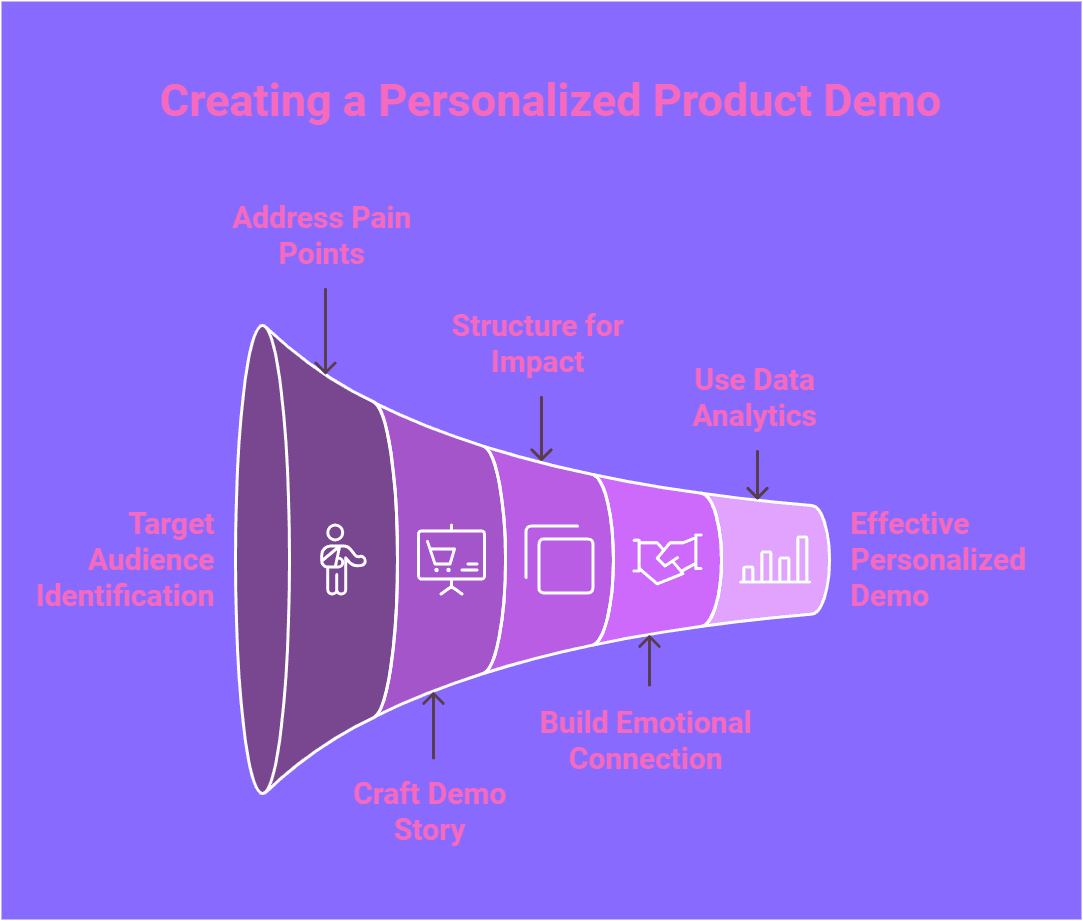
Now that we understand personalized product demos and why organizations need them let's examine the important steps required to create one.
1. Identifying the target audience and their needs
To create impactful product demos, research who your audience is, what they value, and their pain points. Develop customer personas that encapsulate these insights to guide your demo’s content, tone, and context.
The more you know about your audience, the more effectively you can craft a personalized demo that resonates and converts. Understanding your prospective customers’ needs and perspectives is also essential.
This insight helps tailor your demo to address their specific challenges and expectations, guiding you on which features to emphasize and what language to use.
2. Discovering and addressing pain points and goals
As mentioned earlier, it’s crucial to identify your potential customer’s pain points and goals to craft a compelling product demo. But how can you do that? Use research, user interviews, surveys, or feedback from your sales team to uncover these insights.
Common pain points might include:
Inefficiency: Struggles with outdated tools that waste time and resources.
Cost: There’s a need for a cost-effective solution with a higher ROI.
Quality: Dissatisfaction with the quality of current solutions.
Integration: Challenges with integrating disparate systems.
Address these issues directly in your demo, showcasing how your product resolves these pain points and delivers value to attract potential customers.
Also Read: How to Conduct a Successful Software Demonstration?
3. Creating a personalized demo story around your product
Personalization boosts the impact of your product demos if done the right way. Automate and tailor your demo to show how your product fits their specific workflow and context, making it more relevant and engaging.
Position your product as a solution to their challenges—whether it’s saving costs, enhancing efficiency, or facilitating growth. For example, if cost-saving is a key issue, demonstrate how your product can significantly reduce expenses.
Finally, end with a clear vision of the transformation your product offers. Here, you can highlight the positive changes they expect, leaving a strong, memorable impression.
4. Well-structure demo for maximum impact
Do you think you have the solution to your target audience’s problem? Great, but without structuring the demo well, it can't bring you clients. A well-structured interactive demo acts as a trail map, guiding viewers through understanding your product's value by choosing a specific use case.
Begin by presenting the problem or need your product addresses. Then, showcase your product’s solution using engaging examples or demonstrations related to that use case.
Lastly, conclude by connecting your product’s benefits to the initial problem, reinforcing how it effectively meets your viewers' needs. This structured approach ensures a compelling and memorable presentation.
Here is a simple structure for crafting your demo:
Phase | Description |
Problem identification | Address the customer's issue and empathize. Illustrate that you understand their pain points. |
Solution demonstration | Showcase and explain the core features of your product and how they can resolve the identified problem. |
Benefits Overview | Reiterate your product’s benefits that solve the expressed problems, showing the value and advantages they can expect. |
You should also consider using top-notch demo automation software like SmartCue to boost engagement by seamlessly guiding potential buyers through product demos. A platform like SmartCue ensures the demo remains focused, concise, and flows naturally, keeping the viewer engaged while effectively communicating your product's value proposition.
5. Building an emotional connection in your demo
Earlier, sales representatives used to cold call to sell, which isn’t the best idea now. Instead, you should focus on establishing an emotional connection during your demo to drive engagement and influence decisions.
Emotion is a powerful factor in purchasing choices, and customers are more likely to invest in a product they feel connected to. Start by vividly illustrating the audience's current struggles and showing empathy.
As you highlight your product’s features, emphasize the positive emotions they will experience once their problem is resolved—whether it's relief, pride, or confidence. Incorporate authentic case studies or testimonials to build trust and credibility.
6. Using data and analytics for personalization
Data and analytics are essential for refining your product or sales demo environment to meet individual needs. Collect and analyze information from website visits, email engagement, social media interactions, and past demo experiences to understand customer behavior and interests, all of which can be tracked through your CRM.
You must consider these data-informed strategies:
Customer segmentation: Diversify your demo content based on key characteristics or categories like industry, job role, company size or their specific issues.
Behavioral targeting: Personalize your demos to align with their patterns of behavior across various touchpoints.
Predictive analytics: Foresee customer needs and preferences using historical data and identifying patterns.
Real-time personalization: Adapt your demos dynamically based on real-time customer behaviors and responses.
Leveraging these strategies, you can create meticulously crafted personalized product demos. These will demonstrate to your customers that you acknowledge and have solutions to their unique needs and present your product's value in the most relevant context.
7. Laying the groundwork for a successful product demo
Effective pre-demo preparation lays the foundation for a successful, personalized presentation and makes onboarding potential buyers easier. Start by researching your target audience to understand their problems, goals, and preferences. Use this insight to craft a demo with tailored content focused on the features that matter most to them.
Prepare your toolkit with relevant visuals, statistics, case studies, and other materials customized for each customer. Adapt the demo flow to align with their specific interests and emphasize features that address their needs in the sales funnel.
During the demo, use industry-specific language or their terminology to build rapport aonate with your audience. With thorough preparation, you’ll be ready to deliver a compelling, personalized product demo that makes a strong impact.
8. Ensuring smooth demo execution
Executing a smooth and interactive product presentation is crucial for a personalized demo.
Here’s how it enhances personalization:
Identify Key Markers: Create checkpoints to ensure you cover points relevant to each audience segment, keeping the demo focused on their unique needs.
Interactive Elements: To make the demo more relevant, tailor it in real time with questions and feedback to encourage audience participation.
Master Transitions: Seamless transitions maintain flow and keep the focus on how your product addresses specific issues, enhancing the personalized narrative.
Prepare for Tech Failures: Have contingencies to avoid disruptions, ensuring the demo remains smooth and professionally delivered, maintaining focus on personalization.
Anticipate Objections and Questions. Prepare responses to potential concerns to keep the demo aligned with the attendees' specific interests and effectively address their pain points.
Remember that personalizing your product demo is about delivering a tailored, engaging experience. Proper execution ensures that your personalized content is presented clearly and effectively, making a stronger impact.
9. Handling questions and objections with ease
Handling questions and objections during a sales or demo is a chance to personalize your presentation.
Here’s how:
Be ready: Prepare answers for common questions or concerns specific to your audience.
Admit uncertainty: If you don’t know the answer, be honest. Promise to find out and follow up.
Empathize and reassure: Show that you understand their concerns and explain how your product can help.
Follow-up: Make sure their questions are fully answered and check if they need more information.
Revisit: If their questions hint at more profound issues, go back and clarify any confusing points.
Each question or objection is an opportunity to show how well your product meets their needs and to move the sales demo process forward.
10. Evaluating the success of your personalized product demos
Measuring demo impact and effectiveness through customization is crucial to keep improving your personalized interactive product demos. This means regularly tracking key success metrics and collecting customer feedback after each demo.
Analyzing this data allows you to make informed, data-driven decisions to refine your approach. Regular evaluation also ensures your demos stay effective and relevant in a constantly changing market.
11. Keeping track of success metrics
Tracking success metrics is invaluable for evaluating the effectiveness of your personalized product demo. It offers actionable insights into customer behavior, engagement levels, and the overall impact of your demo software.
Metrics you could consider keeping track of include:
Metric | Purpose |
Engagement Metrics | To gauge the level of interest and interaction from your audience, you can use metrics like demo completion rates, time spent on particular features, and interactions during the demo. |
Conversion Rates | To assess the conversion potential of your live demo. This could involve tracking demo-to-opportunity conversion rates, opportunity-to-close rates, and overall revenue impact. |
Customer Feedback | To assess customer perceptions, satisfaction levels, and likelihood to purchase based on their qualitative feedback post-demo. |
A/B Testing | To compare the effectiveness of different demo personalization strategies, messages, or demo flows. The insights gained from these tests can be used to optimize your approach further. |
By monitoring these metrics, you can tweak your approach, iterate on your demo strategy, and ensure continuous improvement of your marketing efforts.
12. Improving your demo strategy with feedback
Feedback from both customers and your team is key to improving the customization of your SaaS demos’ customization better. Customer feedback reveals how well your demo engaged customers, addressed their needs and highlighted the most relevant points. Team feedback helps spot areas where communication might have faltered or where customers had questions.
After each demo, gather and review this feedback to identify common themes and issues. Use these insights to tweak your demo—whether it’s refining your narrative, emphasizing certain features, simplifying explanations, or adding interactive elements.
Think of refining your demo as an ongoing process. By continuously improving based on feedback, you'll ensure your demos remain engaging and effectively showcase your product’s value.
Discover the Impact of SmartCue: 3 Inspiring Personalized Product Demos Examples
Curious about the difference SmartCue can make? Dive into these success stories and see them in action!
1. Simply Fleet
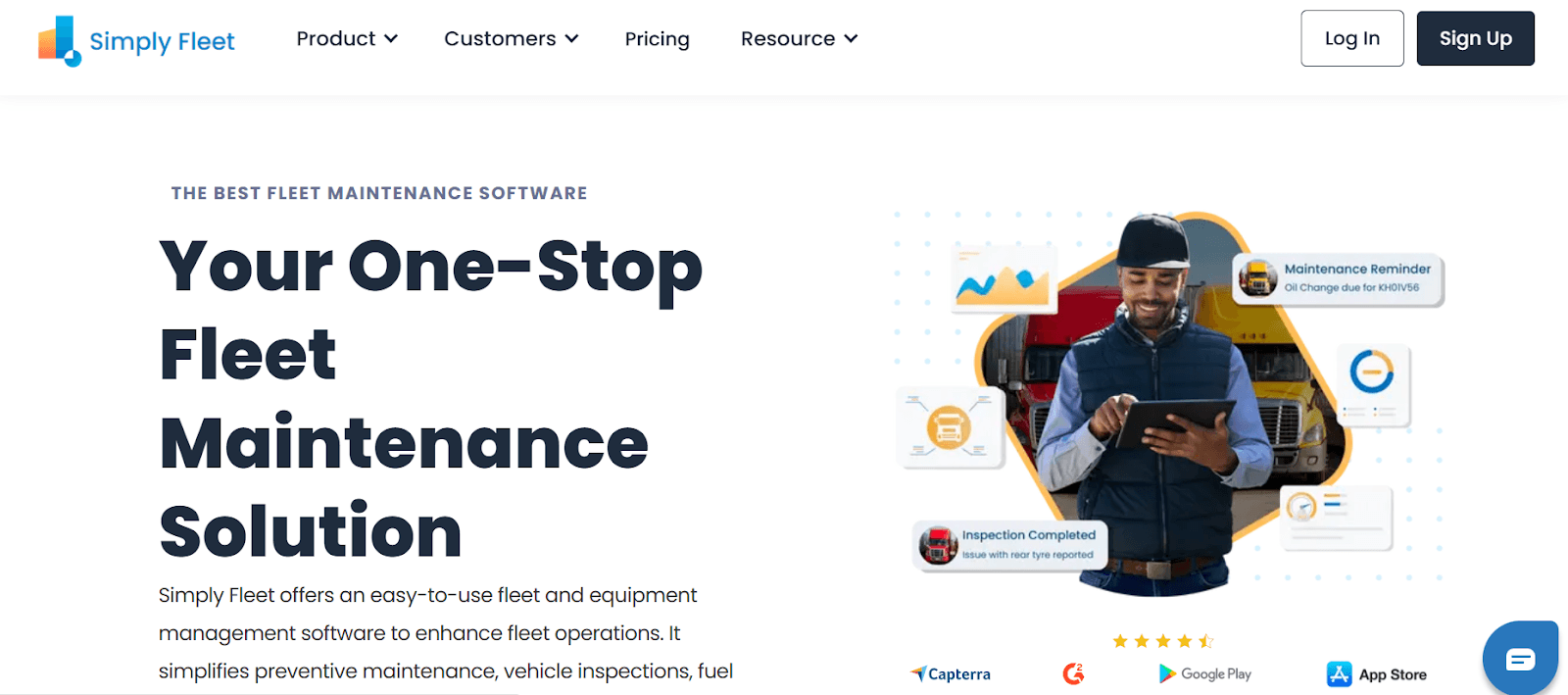
Simply Fleet uses SmartCue to offer personalized product demo tours that make exploring their fleet management software simple and engaging. These tours guide users through key features, ensuring they quickly understand how to use the platform to its full potential.
With SmartCue, onboarding is seamless, and tutorials help users adopt new functionalities effortlessly. This approach ensures customers can maximize the benefits of Simply Fleet’s tools while staying updated on the latest features.
2. YaalaGo

YaalaGo, a Travel Agency CRM, uses SmartCue to deliver personalized product demos tailored to travel professionals. These demos showcase key features like trip management, GDS parsing, and client management, helping agents streamline workflows.
With seamless onboarding and targeted tutorials, YaalaGo ensures users quickly adopt the all-in-one Sabre Companion Tool and other essential features, maximizing productivity.
3. Employee Cycle
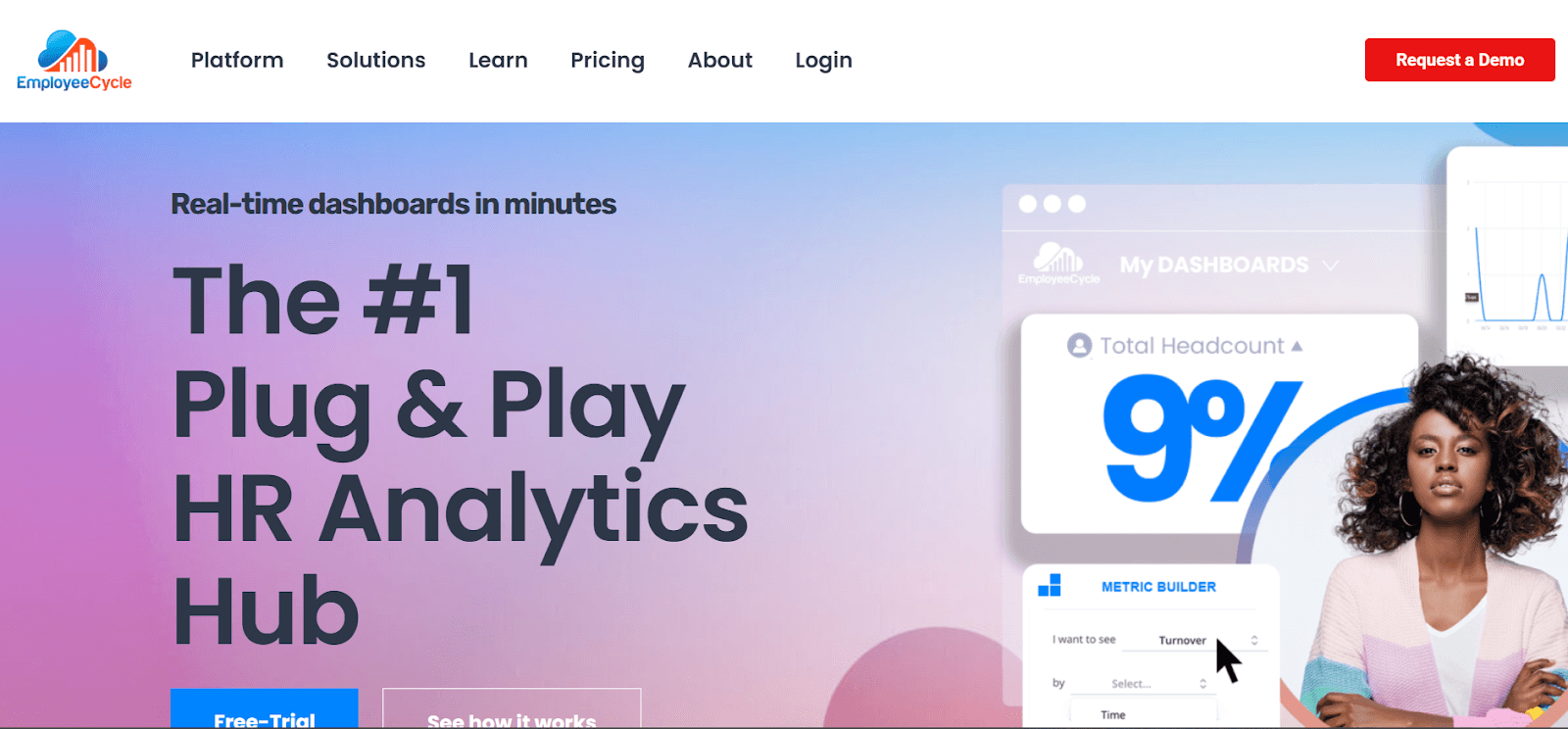
Employee Cycle, a platform for HR data visualization, uses SmartCue to deliver personalized self-serve product demos tailored for HR professionals. These demos showcase the platform’s analytics capabilities, helping users quickly understand how to centralize and streamline their HR data.
With SmartCue, Employee Cycle provides onboarding modules to familiarize users with data visualization tools and tutorials that emphasize the benefits of automated reporting. This approach has also helped them improve lead quality and shorten sales cycles by pre-qualifying leads early in the process.
Want to personalize your demos? Get started with SmartCue today
SmartCue, an automation demo tool, changes the game by turning hesitant visitors into engaged leads with interactive product tours and customizable demos. Unlike plain demo videos or screenshots, SmartCue provides a dynamic, hands-on experience to make the process easier and increase viewer engagement and conversions. Check out SmartCue and see how it can improve your presentations quickly. Take a quick tour now!
Our easy-to-use tools let you easily record, personalize, share, and analyze demos, saving you time and boosting your ROI. Trusted by companies worldwide, SmartCue makes your demos impactful and in line with your sales goals. Try SmartCue with a 14-day free trial and see the difference. Book a live demo today!
Conclusion
Personalized product demos are crucial in today’s competitive market. For product managers, creating demo videos tailored to each customer’s needs can transform their marketing strategy. Understanding their audience and using data to personalize their demos helps them connect with their customers on a deeper level.
You should aim to showcase your product’s capabilities and illustrate the positive changes it can bring to your customers' lives. Embrace personalization in your demos to boost engagement, build lasting customer experience relationships, and drive growth. Your effort to craft these demo experiences will lead to better results and stronger customer connections.
Frequently Asked Questions
What are the benefits of personalized product demos?
Personalized product demos can enhance the relevance and engagement of your presentations, increase understanding, and bring about a distinct emotional resonance with your product, thereby augmenting the likelihood of conversion.
What are personalized products?
Personalized products are unique items or services tailored to meet a customer’s specific needs, preferences, or demands, providing a more tailored and satisfying user experience.
How can I identify the needs of my target audience?
Identifying the needs of your target audience involves research, surveys, feedback analysis, and interaction. Understanding their interests, pain points, and motivations will help shape a product demo that feels personal and relevant.
What data should be collected and analyzed for personalization?
Collect and analyze data that provides insights into customer behavior, preferences, and pain points to enhance personalization. This could include web analytics, purchase history, customer feedback, social media interactions, and more.
Comments
Your comment has been submitted successfully!